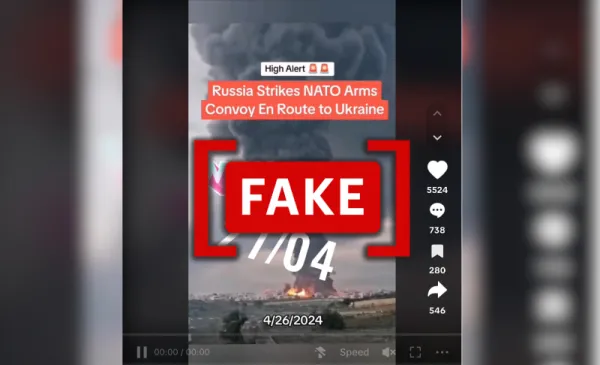By: Naledi Mashishi
May 1 2024
No, Russia didn’t strike a NATO arms convoy en route to Ukraine

Screenshot of a viral video falsely claiming to show a Russian strike on a NATO convoy. (Source: TikTok/Screenshot)
The Verdict False
The video does not show a strike on a NATO convoy, but a factory fire in Hebron, and a Russian strike on a hydroelectric dam in Ukraine.
What is the claim?
A TikTok video posted on April 27, 2024, claims that Russia struck a NATO arms convoy that was en route to Ukraine. The video shows footage of buildings on fire taken from a distance while the sound of emergency vehicle sirens can be heard. It includes a second clip of what appears to be a vessel being struck from a closer angle.
The claim has been shared on other social media sites, such as Facebook. One Facebook user shared a clearer video version with the caption, “More US $ and UK £ taxpayer millions goes up in smoke.....Did NATO really think they were going to allow a second Nazi regime directly on their border?”
The Facebook version claims the strike happened on April 26, while the TikTok claims it occurred on April 27.
But we haven’t found any evidence that Russia struck a NATO arms convoy en route to Ukraine on either of those dates. The video uses old footage from different countries taken in February and March 2024.
What we found
Reverse image searches reveal the true origins of the clips. The first clip showing buildings on fire from a distance is a mirror-flipped version of the footage that was first posted on TikTok on February 27 by a Palestinian user. It shows a factory fire at the Royal Plastic Industries Factory in Hebron, Palestine.
Left: Screenshot from TikTok video claiming Russia struck a NATO convoy. Right: Screenshot taken from original footage of factory fire in Hebron. The skyline, buildings, and plumes of smoke match in both videos, but they have been mirror-flipped. (Source: Screenshots/TikTok)
The large fire triggered a state of emergency, leading to the surrounding neighborhoods being evacuated while firefighters attempted to contain the blaze. The video has been the subject of misinformation since and has also been shared with false claims that it depicts an Israeli retaliatory attack against Iran.
The second clip, showing a close-up of a vessel being struck, is a mirror-flipped version of footage that was first posted on X (formerly known as Twitter) by media outlet CGTN America on 22 March 2024. The original video depicts Russian missiles hitting the hydroelectric DniproHES Dam in Zaporizhzhia, a city in southeastern Ukraine.
Images from left to right showing a screenshot of TikTok video claiming Russia struck a NATO arms convoy, a screenshot of the claim reshared to Facebook, and a screenshot of the original footage of a Russian attack on a dam in Ukraine. The matching infrastructure, lighting, and background indicate the first two screenshots are mirror-flipped images of the third. (Source: Screenshots/TikTok/Facebook/X)
CGTN America reported that the dam attack was the largest Russian attack on Ukrainian energy infrastructure since the war began. The attack caused at least three deaths and widespread power blackouts.
We could not find any evidence or official reports of Russia striking a NATO arms convoy on April 26 or 27.
The verdict
A widely shared video on TikTok and Facebook claims to depict a military airstrike by Russia on a NATO arms convoy en route to Ukraine. However, the video uses unrelated footage from a large factory fire in Palestine and a Russian attack on a hydroelectric dam in Ukraine. We have not found any evidence that Russia struck a NATO arms convoy en route to Ukraine. We have therefore rated this claim as false.


